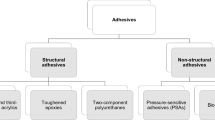
Overview
- Gathers the advantages of the combining different jointing techniques
- Covers all hybrid techniques of bonding
Part of the book series: Advanced Structured Materials (STRUCTMAT, volume 6)
Buy print copy
About this book
This volume presents treat the material science and mechanical issues of hybrid adhesive bonds which are a combination of adhesive bonding rather than mechanical fasteners. The idea of hybrid joints is to gather the advantages of the different techniques leaving out their problems. Some of the advantages of these joints are a higher static and fatigue strength and a higher stiffness with respect to simple joints, a two-stage cracking process before the final failure and improved durability.
The book treats all important kinds of joints which are in use today: weld – adhesive, rivet – adhesive, clinch – adhesive, bolt – adhesive, and adhesive – adhesive. A section dedicated to threadlocking and interference-fit adhesive joints is also included. All sections are treated from a scientific point of view with modeling issues supported by simple coupons testing and a technological point of view where the idea is to present more applied results with practical cases.
Similar content being viewed by others
Keywords
Table of contents (10 chapters)
-
Front Matter
Editors and Affiliations
Bibliographic Information
Book Title: Hybrid Adhesive Joints
Editors: Lucas F. M. Silva, Alessandro Pirondi, Andreas Öchsner
Series Title: Advanced Structured Materials
DOI: https://doi.org/10.1007/978-3-642-16623-5
Publisher: Springer Berlin, Heidelberg
eBook Packages: Chemistry and Materials Science, Chemistry and Material Science (R0)
Copyright Information: Springer-Verlag Berlin Heidelberg 2011
Hardcover ISBN: 978-3-642-16622-8Published: 29 June 2011
Softcover ISBN: 978-3-642-26898-4Published: 03 August 2013
eBook ISBN: 978-3-642-16623-5Published: 27 June 2011
Series ISSN: 1869-8433
Series E-ISSN: 1869-8441
Edition Number: 1
Number of Pages: VIII, 309



